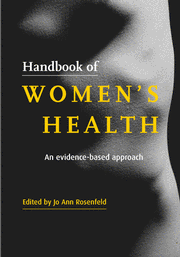Book contents
- Frontmatter
- Contents
- List of contributors
- Common abbreviations used in the text
- Normal blood values in women and during pregnancy
- Introduction
- 1 Singular health care of women
- Preventive care
- 2 Preventive care of adolescents
- 3 Preventive care of adults(19 to 65 years)
- 4 Preventive care for older adults
- 5 Cigarette smoking and cessation
- 6 Nutrition
- 7 Exercise
- Psychosocial health
- Sexuality
- Genitourinary medicine
- Breast disorders
- Psychological disorders
- Common medical problems
- Index
3 - Preventive care of adults(19 to 65 years)
Published online by Cambridge University Press: 28 October 2009
- Frontmatter
- Contents
- List of contributors
- Common abbreviations used in the text
- Normal blood values in women and during pregnancy
- Introduction
- 1 Singular health care of women
- Preventive care
- 2 Preventive care of adolescents
- 3 Preventive care of adults(19 to 65 years)
- 4 Preventive care for older adults
- 5 Cigarette smoking and cessation
- 6 Nutrition
- 7 Exercise
- Psychosocial health
- Sexuality
- Genitourinary medicine
- Breast disorders
- Psychological disorders
- Common medical problems
- Index
Summary
Preventive health care for adult women consists of active intervention and counselling to help to prevent the common causes of death. Screening, counselling, and immunizations can dramatically reduce morbidity and premature mortality in women.
Introduction
Causes of mortality
The five leading causes of death in women in the USAare, to a large extent, preventable, and the risk factors responsible for each cause may be modifiable1 (Table 3.1). Primary care physicians can specifically intervene in the form of screening, immunizations, and counselling and can dramatically reduce morbidity and premature mortality in women (Appendix 3.1).
Strength of evidence
As with other clinical practices, providers should carefully evaluate individual preventive services before incorporating them into routine practice. In general, preventive interventions should not be used unless they have been demonstrated to be effective in well-designed studies. Expecting every physician to assess the quality of scientific evidence for each preventive service individually is unrealistic. Therefore many authorities, including professional societies, government agencies, ad hoc committees, voluntary associations, academic experts and consensus panels have made recommendations for the prevention of disease. Well-known examples include the CDC, US Preventive Services Task Force (USPSTF) and American Cancer Society (ACS). Some organizations' policy statements do not describe the methods used to generate their recommendations. Others, notably the USPSTF, provide a detailed description of the methodology used. Therefore, clinicians must be discerning consumers of recommendations made by preventive care authorities. Preventive care recommendations differ.
- Type
- Chapter
- Information
- Handbook of Women's HealthAn Evidence-Based Approach, pp. 25 - 41Publisher: Cambridge University PressPrint publication year: 2001
- 1
- Cited by

